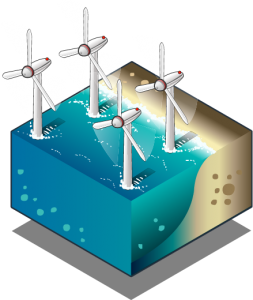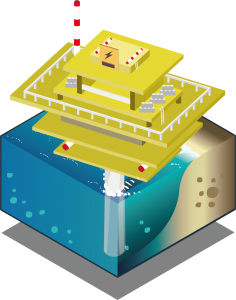Rampion 2’s Development Consent Order permits:
Offshore
Onshore
A full description of the Proposed Development is provided in the Environmental Statement, Volume 2, Chapter 4: The Proposed Development.

The offshore wind farm site is adjacent to and forming an extension to the west and south of the existing Rampion Offshore Wind Farm, a minimum of approximately 13km off the Sussex coast.
The Application form and accompanying documents including plans and maps, the Environmental Statement (ES) and Non-Technical Summary (NTS) can be viewed and downloaded free of charge on the Rampion 2 page on the Planning Inspectorate website.
There is a lot of information and documentation so to help navigate and find what you are looking for, please see our Guide to the Application, which sets out an index for all the documents we have submitted.
The Non-Technical Summary (NTS) can also be found here, along with the Onshore Work Plans and Offshore Work Plans.
The Examination process closed on 6th August 2024, and the Secretary of State for the Department of Energy Security and Net Zero granted development consent for Rampion 2 on the 4th April 2025.
A typical offshore wind farm will be made up of an array of offshore wind turbines that are fixed to the seabed. The wind turbines feed green power into offshore substations via underwater cables.


A typical offshore wind farm will be made up of an array of offshore wind turbines that are fixed to the seabed. The wind turbines feed green power into offshore substations via underwater cables.


Underwater export cables transmit the electricity to a landfall location where the offshore cables are jointed to the onshore cables. The cables can be drilled under a beach. From there, the cables can be run underground through to an onshore substation. The role of an onshore substation is to transform the electricity to flow at the correct voltage and frequency into the nation’s transmission system.


Underwater export cables transmit the electricity to a landfall location where the offshore cables are jointed to the onshore cables. The cables can be drilled under a beach. From there, the cables can be run underground through to an onshore substation. The role of an onshore substation is to transform the electricity to flow at the correct voltage and frequency into the nation’s transmission system.
The Planning Inspectorate, on behalf of the Secretary of State (SoS), has 28 days to decide whether the DCO application meets statutory requirements. As part of this process, the Planning Inspectorate consults local authorities on the adequacy of our consultation

The Planning Inspectorate accepts our application for examination, appoints Examining Authority and launches Rampion 2 webpage to publish DCO process and documentation. We publicise the application, setting out how to register as an ‘Interested Party’ and submit ‘Relevant Representations’ to express opinions

The Examining Authority makes an initial assessment of the application, updates Interested Parties, then holds a Preliminary Meeting to outline the overall timetable for the process and determine how the application should be examined

The Planning Inspectorate completes a full review of the DCO submission within 6 months. There are opportunities for people or groups to send comments in writing and/or request to speak at Public Hearings

On 4th April 2025, the Secretary of State for Energy Security and Net Zero, the Rt Hon Ed Miliband MP, awarded development consent for the Rampion 2 Project.

Rampion 2 is maturing the development of its scope and programme as planned following the award of its DCO. Technical design maturation, stakeholder engagement and overall project derisking are ongoing to enable a successful project.

The proposed Rampion 2 sits within a maximum design envelope that has been established for the purpose of assessing the maximum potential impacts of the project. These key statistics for Rampion 2 are taken from our DCO Application.
Rampion 2 will be located between 13km and 26km from the Sussex Coast in the English Channel – this is the same minimum distance from shore as Rampion.
We have assessed a maximum height of 325m tip height above Lowest Astronomical Tide (that’s up to 2.3 times the existing Rampion turbine height) and will have a 22m minimum air gap above Mean High Water Springs (MHWS).
It is hoped that Rampion 2 will be operational by the end of the decade. Until then, the advances in the technology to generate renewable electricity are predicted to be fast paced. Turbine designers aim to capture and convert as much of the wind’s power into electricity as possible. Greater blade ‘tip heights’ have been key to advances in technology to date. The power of offshore turbines has increased 5-fold in just 20 years. Our assessment of the project’s impacts looks at the maximum foreseeable impacts of the turbine types we might expect to be able to buy in the future.
By assessing maximum parameters for turbines, we have the flexibility to produce an optimal layout for them within this envelope. The turbines will be no taller than the maximum blade tip height that we assess and no closer to the shore than the existing turbines. In October 2022, the Rampion 2 Project Team reduced the maximum number of turbines down from 116 to 90. This was in response to feedback on visual effects and shipping from key stakeholders, including Natural England.
Rampion 2 will be able to power the equivalent of over 1million homes.
We submitted an application for a connection to National Grid, as the owner and operator of the UK’s electricity transmission system. Following their assessments they offered Rampion 2 a connection to the Bolney National Grid Substation. This existing substation can accommodate the large output of electricity that Rampion 2 could supply.
A new onshore substation 2km east of Cowfold is needed to transform the power to 400kV and control the electricity flow onto the national transmission system. Buried cables will then connect to the national grid electrical network via an extension to the National Grid Bolney substation in Twineham, required to connect the power so that it can be used by homes and businesses.